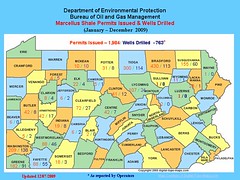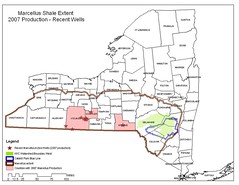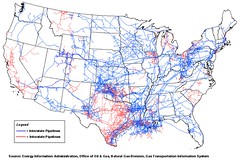Associated Press Writer
KansasCity.com
A blowout at a natural-gas well in a remote area shot explosive gas and polluted water as high as 75 feet into the air before crews were able to tame it more than half a day later, officials said Friday.
The gas never caught fire, and no injuries were reported, but state officials worried about an explosion before the well could be controlled. The well was brought under control just after noon Friday, about 16 hours after it started spewing gas and brine, said Elizabeth Ivers, a spokeswoman for driller EOG Resources Inc.
Pennsylvania, historically an insignificant source of natural gas, is trying to adapt its laws to respond to a furious rush to tap a gas-rich shale formation under its land. The blowout could test the ability of state regulators, who promised an aggressive investigation into the accident. (see DEP Press Release below)
"The event at the well site could have been a catastrophic incident that endangered life and property," Department of Environmental Protection Secretary John Hanger said in a statement. "This was not a minor accident but a serious incident that will be fully investigated by this agency with the appropriate and necessary actions taken quickly."
If the agency finds that mistakes were made, it will take steps to prevent similar errors, he said. It was too early to tell the extent of any environmental damage, he said.
Details about the accident were still sketchy, but the agency was told that unexpectedly high gas pressure in the new well prevented the crew from containing it, said Dan Spadoni, a spokesman for the Department of Environmental Protection.
EOG declined to explain how the accident happened, citing the ongoing investigation. Public safety and protection of the environment are of the utmost importance, the company said in a statement.
President Barack Obama and others have touted exploration of shale as a major new source of clean, homegrown energy. However, lawmakers who are battling for more stringent oversight of such drilling to protect clean drinking water quickly seized on the accident.
"Incidents like this blowout are a reminder that there are dangers and that precautions must be taken to protect the health and well-being of Pennsylvanians," U.S. Sen. Bob Casey said in a statement.
Casey has sponsored a bill to require the industry to comply with the Safe Drinking Water Act and force it to disclose the chemicals it uses in its hydraulic fracturing processes - in which millions of gallons of water, sand and chemicals are blasted underground to shatter tightly compacted shale and release trapped natural gas.
Amy Mall, Senior Policy Analyst, writes on Switchboard, the staff blog of the Natural Resources Defense Council:
"Today a natural gas well blew out in a Pennsylvania state forest during a hydraulic fracturing operation. Officials have estimated that one million gallons of hydraulic fracturing fluid, including chemical additives, plus an undetermined amount of wet natural gas, has blown out of the well. Wet natural gas can contain highly flammable hydrocarbons, like propane and butane, and hazardous substances, such as hydrogen sulfide. These are separated out before natural gas makes its way to your stove or furnace.
Campers and others in the forest were evacuated. While no one wants this kind of toxic explosion in a state forest, imagine if it were near a school or hospital? In this case, the Federal Aviation Administration even had to issue flight restrictions. These hazardous substances will be carried by the air and will settle on land and vegetation. It will be very important to know what chemicals were being used in this hydraulic fracturing operation. Will the company doing the hydraulic fracturing disclose this information to the public?"
David Rensink, the incoming president of the American Association of Petroleum Geologists, said gas well blowouts are very rare and can be very dangerous to control, since a spark can set off an explosion.
Typically, a blowout preventer - a series of valves that sit atop a well - allows workers to control the pressure inside, he said.
Just such a device figured into the massive oil spill off the coast of Louisiana. The oil rig's blowout preventer was supposed to shut off the flow of oil in the event of a catastrophic failure but failed to do so.
The Pennsylvania well is on the grounds of a hunting club in a heavily forested section of Clearfield County, near Interstate 80 and about 90 miles northeast of Pittsburgh.
Houston-based EOG, formerly part of Enron Corp., was drilling into the Marcellus Shale reserve, a hotly pursued gas formation primarily under Pennsylvania, West Virginia, New York and Ohio that some geologists believe could become the nation's most productive natural gas field.
There are more than 1,000 Marcellus Shale wells in Pennsylvania alone, some of them within view of homes, farmhouses and public roads.
There were no homes within a mile of the well, and polluted drilling water was prevented from reaching a waterway, said Spadoni, the department spokesman.
On Friday afternoon, a worker blocked a dirt road to the site, while trucks hauling tanks to remove the polluted water streamed past him. He said he was not allowed to talk about what had happened.
The accident happened just after the crew finished hydraulic fracturing. The crew was clearing out debris from the well when gas shot out of it, Spadoni said.
Workers evacuated the site and contacted county authorities before 10 p.m., said John Sobel, a Clearfield County commissioner. A Pennsylvania Emergency Management Agency spokeswoman said the agency got word after midnight and within the hour notified the DEP. The DEP said it wasn't notified until 1:30 a.m., more than five hours after the blowout.
The polluted water flowing out of the well and into the woods was stopped by a trench and a pump installed by a contractor, Spadoni said. Companies that specialize in securing blown-out wells were called in, he said. ...
FOR IMMEDIATE RELEASE
06/4/2010
COMMONWEALTH OF PENNSYLVANIA
Dept. of Environmental Protection
Commonwealth News Bureau
Room 308, Main Capitol Building
Harrisburg PA., 17120
Neil Weaver, Department of Environmental Protection
717-787-1323
HARRISBURG -- Department of Environmental Protection Secretary John Hanger said today that his agency intends to investigate aggressively the circumstances surrounding a blowout at a Marcellus Shale natural gas well in Lawrence Township, Clearfield County, and take the appropriate enforcement action.
At approximately 8 p.m. on Thursday, June 3, the operators of the well, which is owned by EOG Resources, Inc., lost control of it while preparing to extract gas after hydrofracturing the shale. As a result, the well released natural gas and flowback frack fluid onto the ground and 75 feet into the air. The well was eventually capped around noon on June 4.
“The event at the well site could have been a catastrophic incident that endangered life and property,” said Hanger. “This was not a minor accident, but a serious incident that will be fully investigated by this agency with the appropriate and necessary actions taken quickly.
“When we arrived on scene, natural gas and frack fluid was flowing off the well pad and heading toward tributaries to Little Laurel Run and gas was shooting into the sky, creating a significant fire hazard. That’s why emergency responders acted quickly to cut off electric service to the area.
“Right now, we’re focused on limiting any further environmental damage, but once that work is complete, we plan to aggressively look at this situation and see where things went wrong and what enforcement action is necessary. If mistakes were made, we will be certain to take steps to prevent similar errors from happening again.” (Once again... -Splashdown)
DEP learned of the leak at approximately 1:30 a.m. on Friday after it was informed by the Pennsylvania Emergency Management Agency. DEP immediately dispatched its Emergency Response and Oil and Gas program staff to the site.
PEMA, which elevated its activation level to coordinate resources among multiple state agencies, also worked with PennDOT to initiate an airspace restriction above the well, which the Federal Aviation Administration authorized on a temporary basis earlier today. The restriction prohibits flights at and below 1,000 feet of ground level within a three nautical mile radius of the well site. The restriction is in effect until further notice.
The EOG well pad is located in a rural area near the Penfield/Route 153 exit of Interstate 80 in northwestern Clearfield County. Three other wells on the same pad that have been drilled and fractured remain plugged and are not in danger.
EOG Resources, formerly known as Enron Oil & Gas Co., operates approximately 265 active wells in Pennsylvania, 117 of which are in the Marcellus Shale formation.
For more information, call visit www.depweb.state.pa.us.
DEMAND ACCOUNTABILITY!



















No comments:
Post a Comment